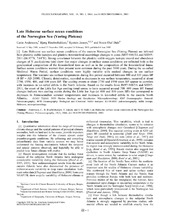Late Holocene surface ocean conditions of the Norwegian Sea (Vøring Plateau)
Peer reviewed, Journal article
Permanent lenke
https://hdl.handle.net/1956/385Utgivelsesdato
2003-06-04Metadata
Vis full innførselSamlinger
- Department of Earth Science [1050]
Originalversjon
https://doi.org/10.1029/2001pa000654Sammendrag
Late Holocene sea surface ocean conditions of the eastern Norwegian Sea (Vøring Plateau) are inferred from planktic stable isotopes and planktic foraminiferal assemblage changes in cores JM97-948/2A and MD95-2011 (66.97°N, 7.64°E). Strong covariance between the planktic stable oxygen isotopic record and abundance changes of N. pachyderma (sin) show that major changes in surface ocean conditions are reflected both in the geochemical composition of the foraminiferal tests as well as in the composition of the foraminiferal fauna. Surface ocean conditions warmer than present were common during the past 3000 years. During the so-called Medieval Warm Period, surface conditions were highly variable with marked changes in sea surface temperature. The warmest sea surface temperatures during this period occurred between 800 and 550 years BP (0 BP = AD 2000). Climatic deterioration, recorded as decreases in sea surface temperature, occurred at about 2750, 1550, 400, and 100 years BP. The cooling events at about 2750 and 1550 years BP appear to correlate with increases in ice-rafted debris in the North Atlantic. Based on the results from JM97-948/2A and MD95-2011, the onset of the Little Ice Age cooling trend seems to have occurred around 700–600 years BP. Faunal changes indicate two cooling events during the Little Ice Age (at 400 and 100 years BP) that correspond to decreases in Fennoscandian summer temperatures and increases in ice-rafted debris in the eastern North Atlantic.
